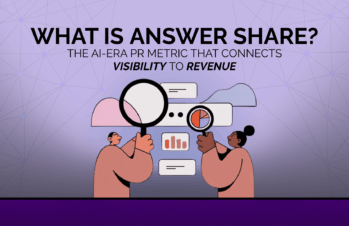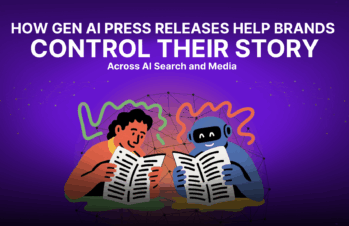When you think of PR, maybe you think of:
- Press releases sent out on PR Newswire
- PR professionals behind a podium at a news conference, doing damage control for a client
- Earning a mention in a top news outlet, like The Washington Post or The Wall Street Journal
Of course, you’d be right—that’s all been part of PR for decades, and it still is today. This is despite the massive shift toward digital that’s irrevocably changed every industry, including PR, and brought us the industry’s new, rather mysterious sibling: digital PR.
So what’s so different about digital PR? If it still means getting public recognition for your client or brand—and it does—then why does it matter if it’s technically “digital” or not?
The reason is that digital PR offers a whole set of tools and techniques for reaching audiences that traditional PR doesn’t. While the goals are the same, for the most part, the way you go about reaching them isn’t.
First, let’s define digital PR.
Digital PR at its most basic is PR that is carried out via digital means.
This includes:
- Press releases and pitches sent to digital outlets
- Social media campaigns
- Live video
- Video campaigns
- Mentions and interviews in digital outlets
- Experiential campaigns that include a digital element
- Influencer outreach
As you can see, one of the biggest advantages of digital PR over traditional is that there are lots of ways to reach many more people. When done strategically, a well-timed social media post can reach far more people than a TV commercial (even, sometimes, more than a Superbowl ad, as we demonstrated with our client Dippin’ Dots).
Digital tools also allow for much more specific targeting, so you can make it more likely that you’re reaching the right people—people who will actually be interested in your brand and what you have to say.
In addition, as mentioned above, digital PR can be used specifically for SEO purposes, through link-building and mentions.
Now let’s look at the specific types of efforts that fall under “digital PR.”
1. Press releases and pitches sent to digital outlets
The standard press release still has its place in the PR world, especially if you’re a large company or one that undergoes newsworthy developments frequently—say, you release 6 new products in a single year, or expand to many different markets quickly.
Press releases, and pitches to go with these releases, sent to specific, intentionally chosen journalists and bloggers can definitely earn your brand coverage.
Bloggers and influencers shouldn’t be overlooked—in today’s digital ecosystem, influencers often wield more power than traditional media outlets, especially when it comes to lifestyle industries like beauty and fitness.
If you find an influencer that you’d like to contact, but who doesn’t have an email or other contact info on their website (or, come to that, if they don’t have a website), you can always Direct Message them through Instagram, Twitter, or Facebook. If they’re serious about their influencer status, they’ll check their DMs frequently.
2. Social media campaigns
Social media campaigns are a form of digital PR, and a form of digital marketing—but since we’re talking about PR here, let’s look at how they function in terms of PR.
One hugely important aspect of a social media campaign is that it can build your brand’s online presence through mentions. For example, if you create a giveaway or contest that requires a user to mention your handle, you’ve just upped your online mentions drastically (assuming you advertise and promote the contest effectivelyl).
Mentions are critical to building your brand because Google recognizes mentions as evidence of authority. In fact, as mentioned on Zazzle Media, Google looks at mentions as “implied links.”
So SEO isn’t just link-building anymore—it involves getting people to talk about your brand online.
3. Live video and video campaigns
Live video, like Facebook Live, can be an excellent digital PR tool because it allows you to interact with your audience live, in real time. You can do a live Q&A, stream a demo of your newest product, interview a fellow leader in your industry—there are all kinds of possibilities.
Live video also allows you to connect with your audience on a more personal, immediate level, which is precisely what today’s connected consumer wants. It allows you to address concerns or questions about a new product or service right away, which in itself can be a savvy PR move.
This is especially true if your brand is experiencing a PR disaster like a poorly-timed tweet (although with any crisis, no matter how small, you’ll want to ensure that you’re well-prepared before you say anything to the public).
If live video is a bit too daunting for you, produced video campaigns are another tool in the digital PR toolbox.
We used this medium to great effect for the Navy Exchange—we created a video campaign on the theme “We Believe…It’s More Than Just a Toy.”
The campaign told the story of a boy who buys a Wonder Woman doll in a Navy Exchange store because it reminds him of his mom, who’s deployed. A caring employee tells him that his mom can hear everything he tells the doll. The boy is comforted by this, and feels a deeper connection to his mom even though she’s far away.
The campaign highlighted what the Navy Exchange does, beyond selling products—it helps connect separated family members and loved ones. The video was wildly successful, drawing the attention of the original Wonder Woman herself, Lynda Carter, and it drove home the brand image of the Navy Exchange as a vital servant of military families.
4. Mentions and interviews in digital outlets
Since mentions are “implied links” according to Google, as stated earlier, mentions of your brand, whether through a profile of your company, an interview with a member of your leadership team, or even a quick quote in an article by a major news outlet, can have outsized positive effects on your brand’s digital footprint.
5. Experiential campaigns that include a digital element
Experiential campaigns offer some kind of experience—a consultation, a chance to play a game, or the opportunity to try a brand-new product—that ties in authentically with your brand’s values and persona to attract would-be customers.
Our Chase BizMobile, which we developed for Chase for Business, is an example of an experiential campaign. This mobile consultation station travels to different Chase for Business conferences around the country, offering free, one-on-one consultations between small business owners and Zen’s own digital marketing experts.
Each conference is accompanied by a strong social media push that advertises the BizMobile and gives local business owners a chance to sign up for a slot. It’s been a highly effective way to get the message out that Chase is on the side of small businesses—that they’re invested in their success, and have the tools business owners need to take their enterprise to the next level.
6. Influencer outreach
Since consumers today trust influencers more than they do brands, influencer outreach has become an increasingly important element of any digital PR campaign.
Identifying the right influencers to reach out to is similar to identifying the right journalists to pitch: you want to take the time to understand what they do, become familiar with them, and put in some effort to craft an outreach email that won’t make them feel like just one name in a list of 500 influencers you’re trying to contact.
However, one major difference between approaching a journalist and approaching an influencer is that influencers don’t necessarily need you in the same way a journalist might. Journalists need sources, and they need stories to cover—if you can be a trusted source or provide them with a good story, you’re already very valuable.
Some of the biggest influencers, on the other hand, are likely approached by very high volumes of brands that want to build partnerships, none of whom they could be said to actually need. This is why you must be able to articulate why partnering with you would be a win for the influencer, as well as your brand.
Remember that influencer marketing is about building mutually beneficial relationships—not simply about paying someone to snap a photo of your product and post it on Instagram. That said, if you put in the time up front to create a strong relationship with an influencer, you may be able to see the benefits of it long into the future, not just for the few weeks after your campaign ends.
Digital PR is a world that’s evolving and changing quickly, just like digital marketing. There’s a lot of overlap between the traditional industry and its digital incarnation, but if you don’t understand the nuances that set the two apart, you may find yourself without much to show for your efforts.
Want more? Read Zen’s founder, Shama Hyder’s, article in Forbes, “Here’s Why PR Isn’t Working for You.”




